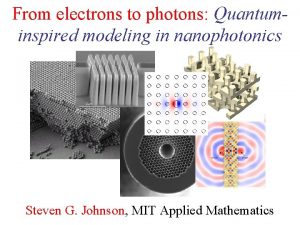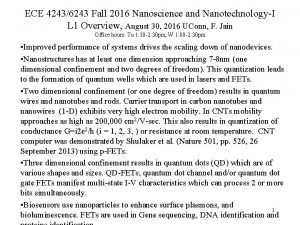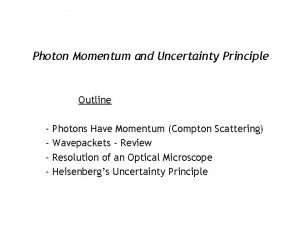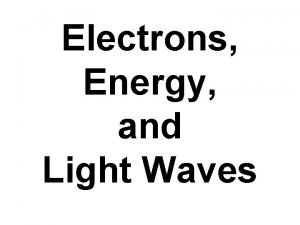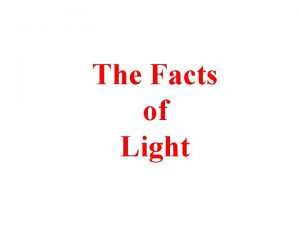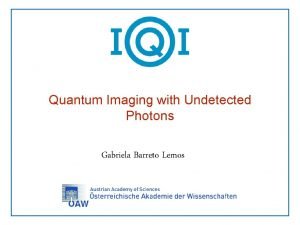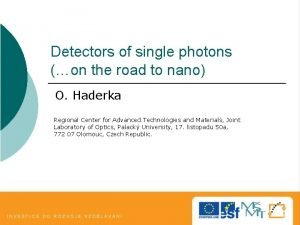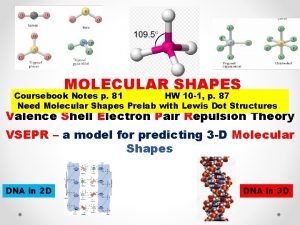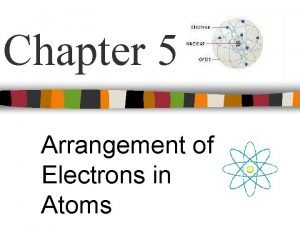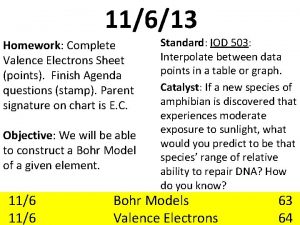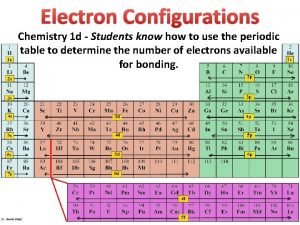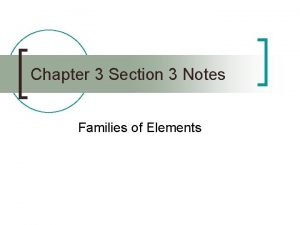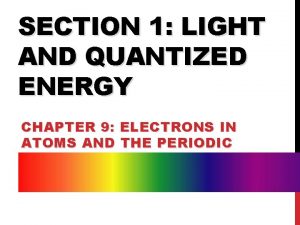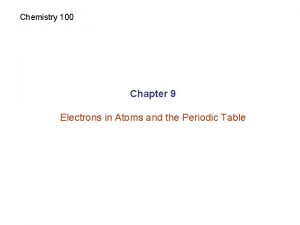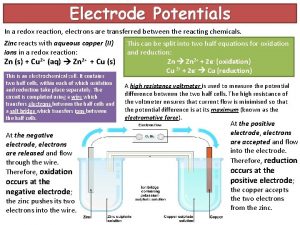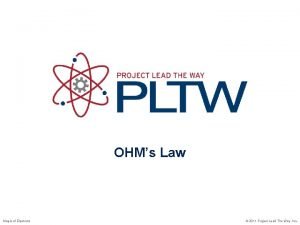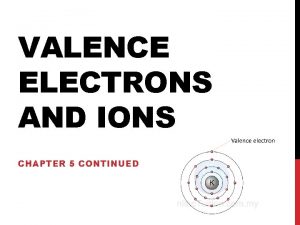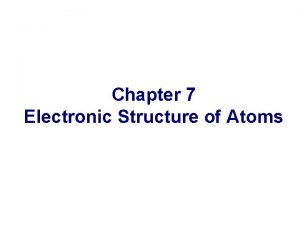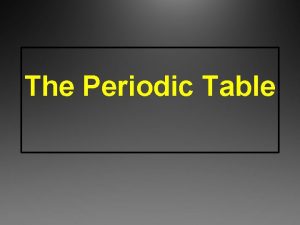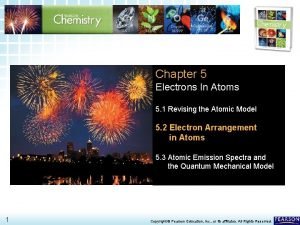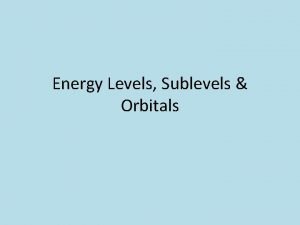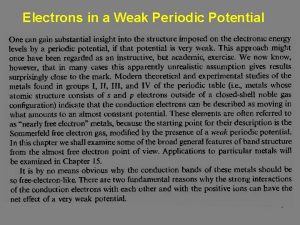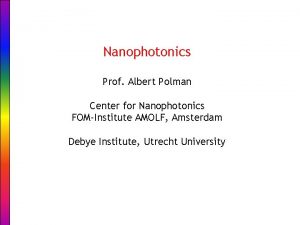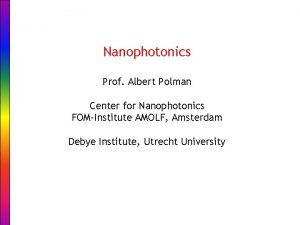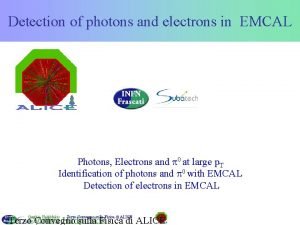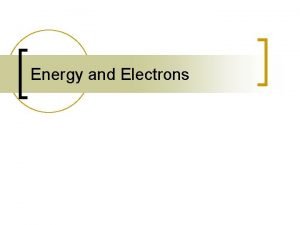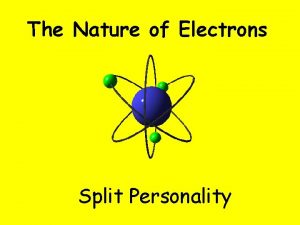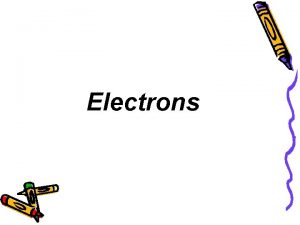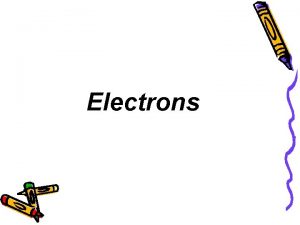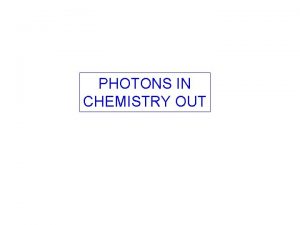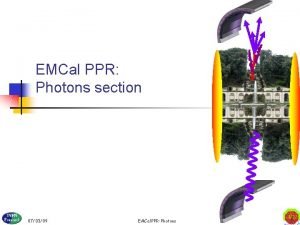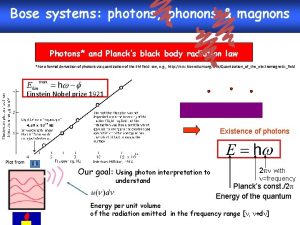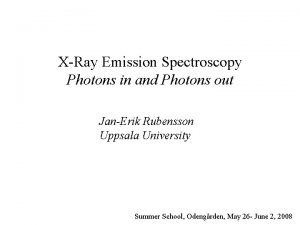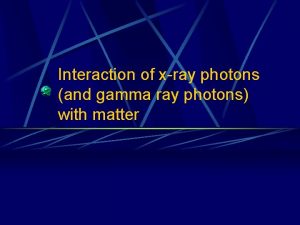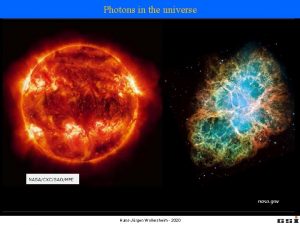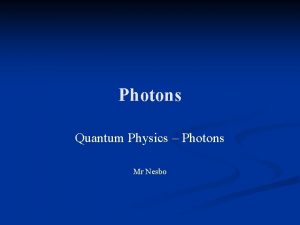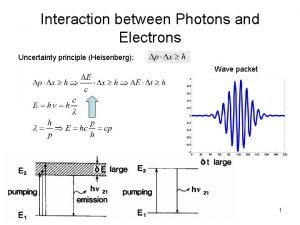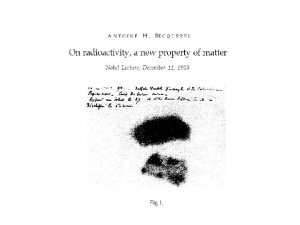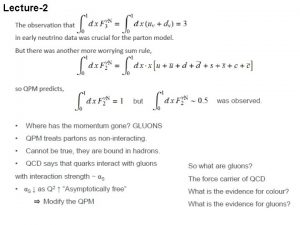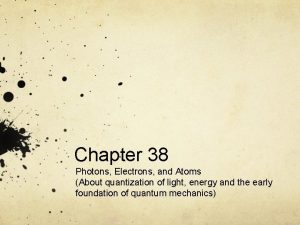From electrons to photons Quantuminspired modeling in nanophotonics

![Nano-photonic media ( -scale) strange waveguides & microcavities [B. Norris, UMN] [Assefa & Kolodziejski, Nano-photonic media ( -scale) strange waveguides & microcavities [B. Norris, UMN] [Assefa & Kolodziejski,](https://slidetodoc.com/presentation_image_h/7b2a45cd8480d60207d8e3d25b8a1a4b/image-2.jpg)




























![Filter-Diagonalization Method (FDM) [ Mandelshtam, J. Chem. Phys. 107, 6756 (1997) ] We want Filter-Diagonalization Method (FDM) [ Mandelshtam, J. Chem. Phys. 107, 6756 (1997) ] We want](https://slidetodoc.com/presentation_image_h/7b2a45cd8480d60207d8e3d25b8a1a4b/image-31.jpg)
![Filter-Diagonalization Summary [ Mandelshtam, J. Chem. Phys. 107, 6756 (1997) ] Umn given by Filter-Diagonalization Summary [ Mandelshtam, J. Chem. Phys. 107, 6756 (1997) ] Umn given by](https://slidetodoc.com/presentation_image_h/7b2a45cd8480d60207d8e3d25b8a1a4b/image-32.jpg)

- Slides: 33

From electrons to photons: Quantuminspired modeling in nanophotonics Steven G. Johnson, MIT Applied Mathematics
![Nanophotonic media scale strange waveguides microcavities B Norris UMN Assefa Kolodziejski Nano-photonic media ( -scale) strange waveguides & microcavities [B. Norris, UMN] [Assefa & Kolodziejski,](https://slidetodoc.com/presentation_image_h/7b2a45cd8480d60207d8e3d25b8a1a4b/image-2.jpg)
Nano-photonic media ( -scale) strange waveguides & microcavities [B. Norris, UMN] [Assefa & Kolodziejski, MIT] 3 d structures [Mangan, Corning] synthetic materials hollow-core fibers optical phenomena

Photonic Crystals periodic electromagnetic media 1887 1987 can have a band gap: optical “insulators”

Electronic and Photonic Crystals dielectric spheres, diamond lattice wavevector interacting: hard problem photon frequency electron energy Bloch waves: Band Diagram Periodic Medium atoms in diamond structure wavevector non-interacting: easy problem

Electronic & Photonic Modelling Electronic • strongly interacting —tricky approximations • lengthscale dependent (from Planck’s h) Photonic • non-interacting (or weakly), —simple approximations (finite resolution) —any desired accuracy • scale-invariant —e. g. size 10 10 Option 1: Numerical “experiments” — discretize time & space … go Option 2: Map possible states & interactions using symmetries and conservation laws: band diagram

Fun with Math First task: 0 get rid of this mess dielectric function e(x) = n 2(x) + constraint eigen-operator eigen-value eigen-state

Electronic & Photonic Eigenproblems Electronic nonlinear eigenproblem (V depends on e density | |2) Photonic simple linear eigenproblem (for linear materials) —many well-known computational techniques Hermitian = real E & w, … Periodicity = Bloch’s theorem…

A 2 d Model System dielectric “atom” e=12 (e. g. Si) square lattice, period a a a TM E H

Periodic Eigenproblems if eigen-operator is periodic, then Bloch-Floquet theorem applies: can choose: planewave periodic “envelope” Corollary 1: k is conserved, i. e. no scattering of Bloch wave Corollary 2: given by finite unit cell, so w are discrete wn(k)

Solving the Maxwell Eigenproblem Finite cell discrete eigenvalues wn Want to solve for wn(k), & plot vs. “all” k for “all” n, constraint: where: H(x, y) ei(k x – wt) 1 Limit range of k: irreducible Brillouin zone 2 Limit degrees of freedom: expand H in finite basis 3 Efficiently solve eigenproblem: iterative methods

Solving the Maxwell Eigenproblem: 1 1 Limit range of k: irreducible Brillouin zone —Bloch’s theorem: solutions are periodic in k M ky first Brillouin zone = minimum |k| “primitive cell” G X kx irreducible Brillouin zone: reduced by symmetry 2 Limit degrees of freedom: expand H in finite basis 3 Efficiently solve eigenproblem: iterative methods

Solving the Maxwell Eigenproblem: 2 a 1 Limit range of k: irreducible Brillouin zone 2 Limit degrees of freedom: expand H in finite basis (N) solve: finite matrix problem: 3 Efficiently solve eigenproblem: iterative methods

Solving the Maxwell Eigenproblem: 2 b 1 Limit range of k: irreducible Brillouin zone 2 Limit degrees of freedom: expand H in finite basis — must satisfy constraint: Planewave (FFT) basis Finite-element basis constraint, boundary conditions: Nédélec elements [ Nédélec, Numerische Math. 35, 315 (1980) ] constraint: uniform “grid, ” periodic boundaries, simple code, O(N log N) 3 [ figure: Peyrilloux et al. , J. Lightwave Tech. 21, 536 (2003) ] nonuniform mesh, more arbitrary boundaries, complex code & mesh, O(N) Efficiently solve eigenproblem: iterative methods

Solving the Maxwell Eigenproblem: 3 a 1 Limit range of k: irreducible Brillouin zone 2 Limit degrees of freedom: expand H in finite basis 3 Efficiently solve eigenproblem: iterative methods Slow way: compute A & B, ask LAPACK for eigenvalues — requires O(N 2) storage, O(N 3) time Faster way: — start with initial guess eigenvector h 0 — iteratively improve — O(Np) storage, ~ O(Np 2) time for p eigenvectors (p smallest eigenvalues)

Solving the Maxwell Eigenproblem: 3 b 1 Limit range of k: irreducible Brillouin zone 2 Limit degrees of freedom: expand H in finite basis 3 Efficiently solve eigenproblem: iterative methods Many iterative methods: — Arnoldi, Lanczos, Davidson, Jacobi-Davidson, …, Rayleigh-quotient minimization

Solving the Maxwell Eigenproblem: 3 c 1 Limit range of k: irreducible Brillouin zone 2 Limit degrees of freedom: expand H in finite basis 3 Efficiently solve eigenproblem: iterative methods Many iterative methods: — Arnoldi, Lanczos, Davidson, Jacobi-Davidson, …, Rayleigh-quotient minimization for Hermitian matrices, smallest eigenvalue w 0 minimizes: “variational theorem” minimize by preconditioned conjugate-gradient (or…)

Band Diagram of 2 d Model System (radius 0. 2 a rods, e=12) frequency w (2πc/a) = a / a irreducible Brillouin zone M G X G TM X E H M G gap for n > ~1. 75: 1

The Iteration Scheme is Important (minimizing function of 104– 108+ variables!) Steepest-descent: minimize (h + a f) over a … repeat Conjugate-gradient: minimize (h + a d) — d is f + (stuff): conjugate to previous search dirs Preconditioned steepest descent: minimize (h + a d) — d = (approximate A-1) f ~ Newton’s method Preconditioned conjugate-gradient: minimize (h + a d) — d is (approximate A-1) [ f + (stuff)]

The Iteration Scheme is Important (minimizing function of ~40, 000 variables) % error no preconditioning preconditioned conjugate-gradient no conjugate-gradient # iterations

The Boundary Conditions are Tricky E|| is continuous E is discontinuous (D = e. E is continuous) e? Any single scalar e fails: (mean D) ≠ (any e) (mean E) Use a tensor e: E|| E

The e-averaging is Important backwards averaging % error correct averaging changes order no averaging of convergence from ∆x to ∆x 2 tensor averaging resolution (pixels/period) (similar effects in other E&M numerics & analyses)

Gap, Schmap? frequency w a G X M But, what can we do with the gap? G

Intentional “defects” are good microcavities waveguides (“wires”)

Intentional “defects” in 2 d (Same computation, with supercell = many primitive cells)

Microcavity Blues For cavities (point defects) frequency-domain has its drawbacks: • Best methods compute lowest-w bands, but Nd supercells have Nd modes below the cavity mode — expensive • Best methods are for Hermitian operators, but losses requires non-Hermitian

Time-Domain Eigensolvers (finite-difference time-domain = FDTD) Simulate Maxwell’s equations on a discrete grid, + absorbing boundaries (leakage loss) • Excite with broad-spectrum dipole ( ) source Dw signal processing complex wn [ Mandelshtam, J. Chem. Phys. 107, 6756 (1997) ] decay rate in time gives loss Response is many sharp peaks, one peak per mode

Signal Processing is Tricky signal processing ? complex wn a common approach: least-squares fit of spectrum fit to: FFT Decaying signal (t) Lorentzian peak (w)

Fits and Uncertainty problem: have to run long enough to completely decay actual signal portion Portion of decaying signal (t) Unresolved Lorentzian peak (w) There is a better way, which gets complex w to > 10 digits

Unreliability of Fitting Process Resolving two overlapping peaks is near-impossible 6 -parameter nonlinear fit (too many local minima to converge reliably) sum of two peaks There is a better way, which gets complex w for both peaks to > 10 digits w = 1+0. 033 i w = 1. 03+0. 025 i Sum of two Lorentzian peaks (w)

Quantum-inspired signal processing (NMR spectroscopy): Filter-Diagonalization Method (FDM) [ Mandelshtam, J. Chem. Phys. 107, 6756 (1997) ] Given time series yn, write: …find complex amplitudes ak & frequencies wk by a simple linear-algebra problem! Idea: pretend y(t) is autocorrelation of a quantum system: time-∆t evolution-operator: say:
![FilterDiagonalization Method FDM Mandelshtam J Chem Phys 107 6756 1997 We want Filter-Diagonalization Method (FDM) [ Mandelshtam, J. Chem. Phys. 107, 6756 (1997) ] We want](https://slidetodoc.com/presentation_image_h/7b2a45cd8480d60207d8e3d25b8a1a4b/image-31.jpg)
Filter-Diagonalization Method (FDM) [ Mandelshtam, J. Chem. Phys. 107, 6756 (1997) ] We want to diagonalize U: eigenvalues of U are eiw∆t …expand U in basis of | (n∆t)>: Umn given by yn’s — just diagonalize known matrix!
![FilterDiagonalization Summary Mandelshtam J Chem Phys 107 6756 1997 Umn given by Filter-Diagonalization Summary [ Mandelshtam, J. Chem. Phys. 107, 6756 (1997) ] Umn given by](https://slidetodoc.com/presentation_image_h/7b2a45cd8480d60207d8e3d25b8a1a4b/image-32.jpg)
Filter-Diagonalization Summary [ Mandelshtam, J. Chem. Phys. 107, 6756 (1997) ] Umn given by yn’s — just diagonalize known matrix! A few omitted steps: —Generalized eigenvalue problem (basis not orthogonal) —Filter yn’s (Fourier transform): small bandwidth = smaller matrix (less singular) • resolves many peaks at once • # peaks not known a priori • resolve overlapping peaks • resolution >> Fourier uncertainty

Do try this at home Bloch-mode eigensolver: http: //ab-initio. mit. edu/mpb/ Filter-diagonalization: http: //ab-initio. mit. edu/harminv/ Photonic-crystal tutorials (+ THIS TALK): http: //ab-initio. mit. edu/ /photons/tutorial/
 Introduction to nanophotonics
Introduction to nanophotonics Applied nanophotonics
Applied nanophotonics Nanophotonics
Nanophotonics Momentum of photon
Momentum of photon Wavelength is equal to
Wavelength is equal to Facts of light
Facts of light Gabriela barreto lemos
Gabriela barreto lemos Gianluca verona rinati
Gianluca verona rinati Erickson nursing theory
Erickson nursing theory Dimensional modeling vs relational modeling
Dimensional modeling vs relational modeling Difference between static and current electricity
Difference between static and current electricity Non bonding electrons examples
Non bonding electrons examples Chapter 5 arrangement of electrons
Chapter 5 arrangement of electrons Sextext of electrons
Sextext of electrons P valence electrons
P valence electrons Does mercury have more protons and electrons than tin
Does mercury have more protons and electrons than tin Valence electron cheat sheet
Valence electron cheat sheet Atomic radius periodic table
Atomic radius periodic table Electrons configurations
Electrons configurations Alkaline earth metal family
Alkaline earth metal family Electrons in atoms section 1 light and quantized energy
Electrons in atoms section 1 light and quantized energy Electrons configurations
Electrons configurations Standard hydrogen electrode conditions
Standard hydrogen electrode conditions Magic of electrons
Magic of electrons Sulfer valence electrons
Sulfer valence electrons Cl2co lewis structure
Cl2co lewis structure How many valence electrons are in tin
How many valence electrons are in tin Selenium unpaired electrons
Selenium unpaired electrons Elements with 7 valence electrons
Elements with 7 valence electrons Chapter 5 arrangement of electrons
Chapter 5 arrangement of electrons Energy levels and orbitals
Energy levels and orbitals Transition element period 5 51 neutrons
Transition element period 5 51 neutrons Does carbon gain or lose electrons
Does carbon gain or lose electrons Empty lattice model
Empty lattice model

